|
Nuclear energy also mulled:
Cheaper power, a reality soon
By Shirajiv SIRIMANE
|
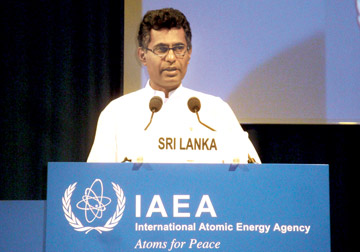
Minister Patali Champika Ranawaka in Vienna
|
"Sri Lanka has highest electricity tariff in region" "CEB losses run
in to billions".
These are some of the headlines which regularly appear in the media
and these have not been denied to date.
The Sunday Observer spoke to the Minister concerned, Patali Champika
Ranawaka, who confirmed that these were true. When asked for the reason,
he had one simple answer.
"Sri Lanka has not built a single power plant from 1990 to 2006". Due
to this the country depended heavily on diesel power generation which is
very costly.
"The arithmetic is simple...the cost of a unit of power was Rs. 17.51
and the CEB sells it to the public at Rs. 13".
In addition, the CEB is also owed billions of rupees from many
government institutions while illegal power tapping too accounts for the
institution to run on a red bill.
"The time has come to change this cycle," the Minister said.
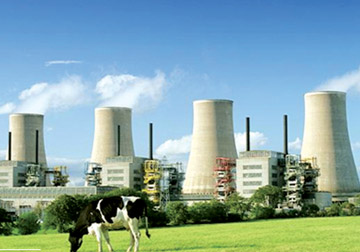
The Tricastin Nuclear Power Plant is one of the 59 French power
plants that provide 75 percent of the country's electricity. |

Norochcholai Power plant |
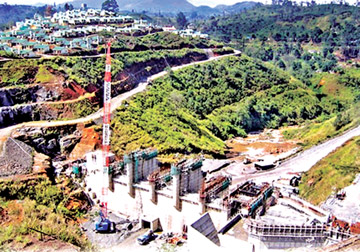
Upper Kotmale Power Plant |
He said the Government has identified the prime reason for the crisis
in the CEB and has decided to construct power plants which were earlier
confined to the drafting stage.
One such project which has got off the ground and is nearing
completion is the Upper Kotmale Power Plant.
Bold political decisions are needed by a developing country to surge
ahead in development and since the country a gained independence, sadly
this has been a gray area.
Whenever a major development project ran in to controversy, political
leaders would ignore it and concentrate on a different project in a bid
to maintain their popularity with the voters.
This was the pattern that was followed for decades. It was President
Mahinda Rajapaksa who changed this political culture, placing
development ahead of anything else.
However, being a true leader of the people, he studied these
controversial projects carefully and brought about changes before
implementing them. He even went to the extent of cancelling some of
them; the relocation of the Weerawila international airport to Mattala
was one classic example.
The Upper Kotmale Hydro Power Plant was to be launched in 1985 and
due to the controversy successive political leaders ignored the project.
However, after the proposal was studied more carefully and some
environmental changes made to the project, it got off the ground and is
expected to be opened by next January. Over 80 percent of the project is
now completed.
Japanese and Sri Lankan engineers have created a 25-hectare reservoir
across the Kotmale Oya and a 35.5 metre tall and 180 metre long dam is
being built across it.
Environmental effects
Environmentalists said the implementation of the project would result
in earthquakes in the hill country and waterfalls running dry.
Opposition politicians too, as usual, capitalised on the controversy,
which delayed the launch of the project.
The President negotiated with the Japan International Cooperation
Agency and secured US $ 297 million on a 30-year long-term credit,
ironing out the other gray area of the project. The Government invested
a further US $ 87 million, making the project a reality. This project
would generate 150 megawatts of power.
Today with the project nearing completion, the myths behind it have
died a natural death.
Two other controversial projects, Norochcholai and Sampur Coal Power
Plants, too have got off the ground. The former will start producing
power in January.
The other project to get off the ground and the first stage to be
opened is the Kerawalapitiya Power Plant.
In addition, improvements being effected in the other power plants
would enable the CEB to switch from high cost power generation methods
to cheaper modes of power generation.
The Minister said they are also seriously considering using nuclear
power to produce electricity.
An electrical engineer himself, the Minister feels that this would be
the future of local power generation.
"Nuclear power generation is nothing new to the region. Tamil Nadu is
already successfully using it," he said.
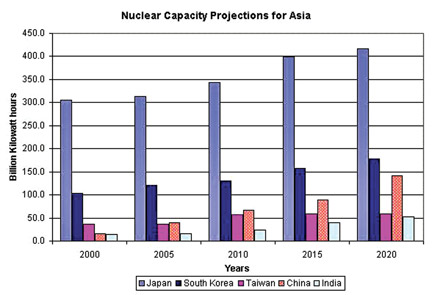 However he admitted that this is not something that can be put in to
place immediately. "It needs a lot of planning and the mindset of the
public too should be changed before we even think of constructing a
nuclear power plant," he said. However he admitted that this is not something that can be put in to
place immediately. "It needs a lot of planning and the mindset of the
public too should be changed before we even think of constructing a
nuclear power plant," he said.
Minister Ranawaka said that one advantage is that nuclear deposits
are available for 100 years. The main reason to explore this is the
cheap cost of power generation. "However, I must admit that it is
initially costly, but Sri Lanka can afford it as this will be
implemented after at least five years," he said.
Pre-feasibility studies are expected to be completed this year
followed by several other studies to find the suitable location. On the
risk of having a nuclear plant in Sri Lanka, he said Sri Lanka is
already in the risk radius as Tamil Nadu has a plant.
"Before the country considers putting up a nuclear plant, we will
launch programs to explain to the public the benefits of nuclear energy.
"Though there is terrorism in Pakistan, to-date there have been no
incidents related to their nuclear facilities while it is the same in
other countries as well," he said.
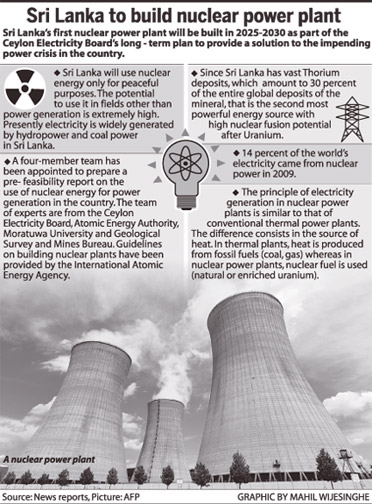 The Minister said they are looking at purchasing nuclear chemicals
from Russia and sending back the waste material for them to dispose
safely. "Germany has introduced nuclear pebbles which are not harmful to
dispose," he said. The Minister said they are looking at purchasing nuclear chemicals
from Russia and sending back the waste material for them to dispose
safely. "Germany has introduced nuclear pebbles which are not harmful to
dispose," he said.
By the time Sri Lanka builds a plant, new methods and innovations
would have been introduced, making nuclear energy even safer. He said,
"Today, with nano technology in place, chances for errors are minimised.
This is why, in the modern world, nuclear disasters are a thing of the
past".
He explained that local technicians have to be trained to man nuclear
power plants while sophisticated machinery too would have to be used.
Just as many conventional thermal power stations generate electricity
by harnessing the thermal energy released from burning fossil fuels,
nuclear power plants convert the energy released from the nucleus of an
atom, typically via nuclear fission.
Thermal energy
A cooling system removes heat from the reactor core and transports it
to another area of the plant, where the thermal energy can be harnessed
to produce electricity or to perform other useful tasks.
He pointed out that they were looking at wind and solar power
generation, but are not too keen to implement them on a large-scale as
storage is very expensive. "The generated power has to be stored in
batteries and this process is very expensive," he said.
"However, we are looking at generating power from dendro, paddy husks
and waste more seriously," he said. The Minister who is back from a
World Congress on Nuclear Energy in Vienna had the opportunity to study
the subject in detail and also the chance to share some of the
experiences of other countries especially Pakistan and India.
In 2009, 13-14 percent of the world's electricity came from nuclear
power. More than 150 naval vessels using nuclear propulsion have been
built.
As of December 2009, the world had 436 nuclear reactors. Since the
production of commercial nuclear energy began in the mid-1950s, 2008 was
the first year that no new nuclear power plant was connected to the
grid, although two were connected in 2009.
The United States produces the most nuclear energy, with nuclear
power providing 19 percent of the electricity it consumes, while France
produces the highest percentage of its electrical energy from nuclear
reactors-80 percent in 2006.
In the European Union nuclear energy provides 30 percent of the
electricity.
Many military and some civilian (such as icebreakers) ships use
nuclear marine propulsion, a form of nuclear propulsion.
|

